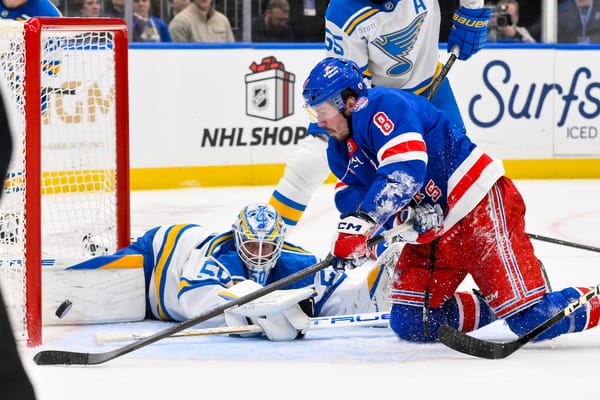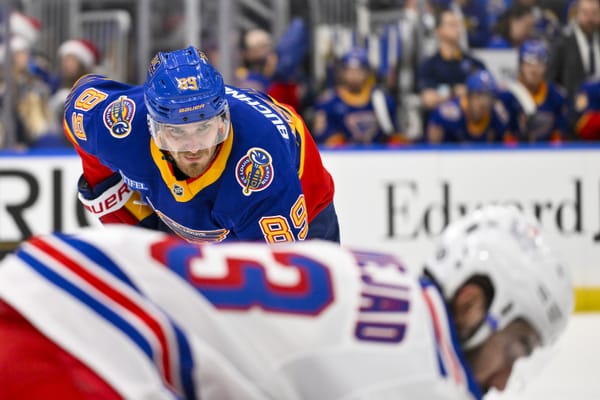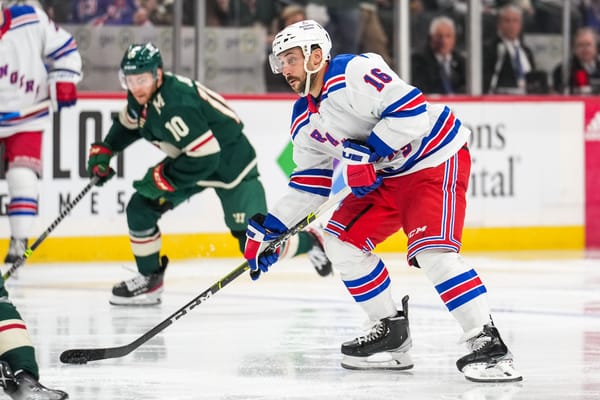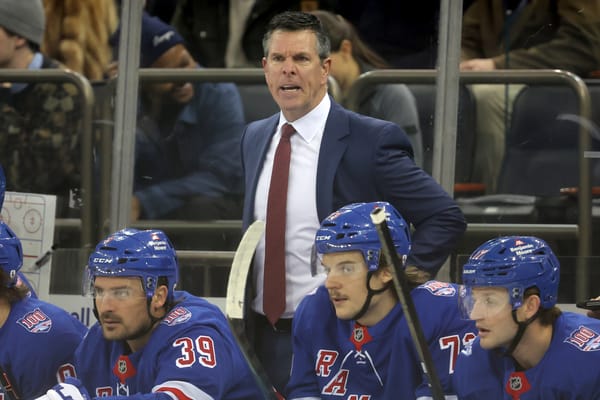Braden Schneider Scouting Report: Analyzing the Rangers’ 19th-Overall Selection
The decision to trade up is highly questionable, but Schneider is a legitimate NHL prospect.
The Rangers’ selection of Alexis Lafreniere first overall was all but a formality heading into Tuesday night, as the pick had effectively been made the second the ping pong ball revealed the organization’s logo at the Draft Lottery on Aug. 10.
What the Rangers would do at 22nd overall was a total mystery, and I’m not sure — for better or worse — that anyone expected that the Rangers would trade up three spots, surrendering the 72nd overall pick in the process in order to draft right defenseman Braden Schneider at No. 19.
We have to analyze this in parts. First, a breakdown of Schneider the player, and second the decision to trade up to select him.
Vitals
Position: Right Defense
Birthday: September 20th, 2001
Height/Weight: 6’2, 209 pounds
2019-2020 WHL Stats: 60 GP, 7 G, 35 A, 42 PIM
Scouting Report
There’s not much to debate about what kind of player Schneider is and can be. He’s a clear-cut shutdown defenseman.
The Prince Albert-native possesses the frame one would expect of that player type. At 6’2 and 209 pounds, he already has NHL size. Yes, he can throw hits with authority, but I’ve seen attempts to paint him as a “big man go boom” defender and it sells short the sophistication and variability of his defensive game.
Mainly, Schneider is a patient defender. He judges spacing very well and uses his size and reach to gradually take away space. He likes to let the puck carrier navigate himself into a metaphorical (sometimes physical) corner until there’s no room to make a play and Schneider can disrupt possession. If he is physical, it’s usually still with care to get his stick involved in the action rather than trying to blow someone up.
Here’s an example on a backcheck (#2 in white).
Schneider’s mission here is to drive the puck carrier wide. Eventually, they reach the boards, all space as been suffocated, and the Czech player has no choice but to punt the puck, which Schneider disrupts even further with an active stick.
Schneider’s gap control is perhaps his best asset. Take this clip from the 2018 Hlinka Gretzky Cup (#7 in white).
There are a few things to notice here. First, while the puck is still in the offensive zone, he astutely notices that his defensive partner is exposed. He backs up behind the blueline. The early detection gave him a fighting chance on the transition rush.
Once his teammate is flat-footed and loses possession, Schneider doesn’t panic. A lesser player may have turned around and attempted to drive directly towards the puck carrier. Instead, Schneider keeps his momentum in the middle lane of the ice, ensuring he’s taking the shortest route back. It’s only once Schneider reaches the blue line and he’s asserted positioning behind the puck that he makes an effortless backward crossover push and turns around to close the gap. Before 18 in blue knows it, his lane to the net is cut off and there’s no space for him to get a shot off.
The examples I have deal with backchecking situations. It’s the same concept on controlled possession plays in his own end. Schneider is successful at driving players wide. Without prior speed generated, it’s difficult to get around him with his stellar combination of positioning and size.
One concern I did have is that he could be beaten to the outside with speed.
However, one NHL scout insisted that I happened to catch him at a bad moment and that plays such as this one are outside the norm for Schneider.
“His feet aren’t amazing, but I don’t think they’ll hold him back,” the scout said.
One area where he invokes mixed feelings is his handling of the puck. While I wouldn’t call him a deer in the headlights, as I would have described Libor Hajek and Sergey Zborovskiy in the past, it’s not the highlight of his game, exactly. He’s not going to rush the puck up the ice ever, really. Instead, he looks for passing outlets. Mitch Brown of EP Rinkside tracked 13 WHL games for Schneider this season and came up with these numbers.
The implication here is bizarre. Schneider was not very good at completing zone entries or exits, and yet he was attempting them with immense frequency. Is this a sign of recklessness and total incompetence?
Not at all. Last season’s Wheat Kings roster featured a miserable collection of offensive defensemen. Schneider was thrust into an extremely unfair position where he was forced to play a role beyond his means. Schneider may not have gifted hands, but he is a heady player who can complete routine passes. In more normal circumstances, the burden of responsibility would be placed elsewhere.
Not to compare Schneider’s overall game to Ryan Lindgren’s, as there are otherwise many differences, but we’ve seen this kind of phenomenon before. Put in a position as primary puck mover, Lindgren falls apart. On a pair with Adam Fox, though, he can delegate possession laterally whenever possible and otherwise find the basic outlets when they’re available.
“It’s fine. Not great but fine,” an NHL scout said of Schneider’s puck-handling.
Schneider produced 42 points in 60 WHL games this past season. That’s quite good production for his player type. He’s conservative in the offensive zone. If he has room, he can wind up and put some quality fastballs towards the net. Otherwise, his role is mostly in support. He sticks to his point, rarely dropping low to gamble on a numbers advantage. He won’t panic with the puck and will find passes to keep the play alive, but he’s not going to create.
The best way to describe his offensive abilities may be “good enough.” Cynical comparisons to Dylan McIlrath floated around social media following the Rangers’ selection, but McIlrath had 24 points in 65 games in his draft year, nearly half of Schneider’s points-per-game rate.
There aren’t really any gaping holes in Schneider’s game. Relative to where he was selected, Schneider is a pretty safe bet to make the NHL. The tradeoff is that his upside, to some degree, is questionable. The flip side of his being relied on as the Wheat Kings’ point man in offensive situations is that it may have inflated his point totals. On a team with better options, he’s not getting on the ice with the first power play unit, nor is he getting that many touches of the puck in the offensive zone at even strength.
As previously noted, he’s physically mature. Since Schneider was born on September 20th, 2001, he is one of the oldest players in this draft class and he will be eligible to play in the AHL for the 2021-2022 season. While that provides confidence in his NHL future and that it may come quite quickly, it brings into question how much more room there is left for him to grow. How much developmental runway is left for his game on the whole? That’s the tradeoff.
Evaluating The Pick
Sometimes two scouts can watch the same player and come away with completely different evaluations. With Schneider, there’s a pretty tight consensus. He projects as a shutdown defenseman on a second-pair alongside a more adept puck mover. One who plays a key role on the penalty kill who will not produce much offense.
“He’s like 3.5/5 across the board in everything,” one WHL scout told Blueshirt Banter in regards to Schneider’s individual abilities.
Was it the right selection? My opinion is that there were more interesting prospects available. The Rangers were in a position to go for a home run.
But I think any attempts to declare that the Rangers blew it are incredibly misinformed and melodramatic. Schneider at No. 19 was perhaps a bit too rich for my blood, but I think he would have comfortably slotted in at, say, 25th overall.
A different scout in Western Canada thought the Rangers got slot value for Schneider.
“Good spot to get (Schneider). Not too high. I had him at 18 for what it’s worth. Very good defensively. Will anchor a shutdown pair. Good enough with the puck to be a basic transition guy.”
Were there better prospects available? I’d argue yes. That doesn’t change the fact that Schneider himself is still a quality prospect.
Evaluating The Trade
The Athletic’s Dom Luszczyszyn estimates that, purely by pick value, trading 22 and 72 to move up to 19 was a minor loss for the Rangers.
errrrr pick 19: 4.2 wins https://t.co/9QxzpaJFQj
— dom luszczyszyn (@domluszczyszyn) October 7, 2020
Per the New York Post’s Larry Brooks, the Rangers leapfrogged the Devils, who owned the 20th pick, on the belief that they had their eyes set on Schneider. That explains why the Rangers felt the need to make a trade.
My bigger qualm is this; why did they feel the need trade up for Schneider? Even optimistic rankings of Schneider had him in the late teens. He wasn’t some sliding gem worth overpaying to steal from New Jersey’s grasp. If the Rangers had naturally owned the 19th pick and he happened to be their best player available then that would be one thing. It wouldn’t be my favorite pick ever, but it would be nowhere near the worst, either. Trading an early third-round pick in order to specifically grab him is where they kind of lose me.
Evaluating His Spot on the Depth Chart
Need should not be a major consideration when trying to find needles in haystacks, and I would hope that wasn’t an influence in the Rangers’ decision to trade up for Schneider.
Still, Schneider does happen to conveniently fit a team need. As I noted in my organizational breakdown prior to the draft, the Rangers were incredibly thin in numbers at right defense beyond the NHL depth chart. Yes, Nils Lundkvist is one of the top prospects in hockey, but almost all their eggs are in that one basket. Schneider gives them a credible addition there.
He is another addition to the team’s increasingly growing list of young defensemen with shutdown capabilities. He, Lundkvist, Matthew Robertson, K’Andre Miller, and Ryan Lindgren offer a staunch base from which the Rangers should be able to internally field a defense corps that can keep pucks out of their net. Right now, that glut is not a problem. It will be interesting to see if enough of them pan out to create a surplus that has to be addressed, but that’s multiple years down the line and a theoretical good problem to have.




